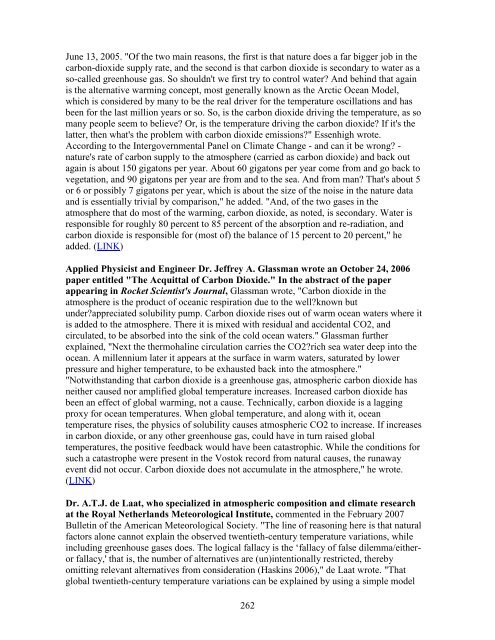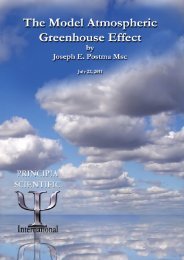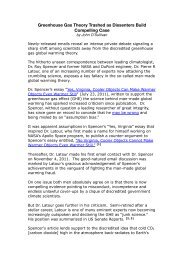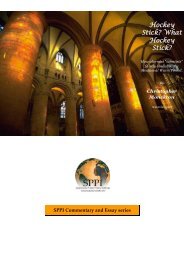Than 1000 International Scientists Dissent Over Man-Made Global ...
Than 1000 International Scientists Dissent Over Man-Made Global ...
Than 1000 International Scientists Dissent Over Man-Made Global ...
You also want an ePaper? Increase the reach of your titles
YUMPU automatically turns print PDFs into web optimized ePapers that Google loves.
June 13, 2005. "Of the two main reasons, the first is that nature does a far bigger job in the<br />
carbon-dioxide supply rate, and the second is that carbon dioxide is secondary to water as a<br />
so-called greenhouse gas. So shouldn't we first try to control water? And behind that again<br />
is the alternative warming concept, most generally known as the Arctic Ocean Model,<br />
which is considered by many to be the real driver for the temperature oscillations and has<br />
been for the last million years or so. So, is the carbon dioxide driving the temperature, as so<br />
many people seem to believe? Or, is the temperature driving the carbon dioxide? If it's the<br />
latter, then what's the problem with carbon dioxide emissions?" Essenhigh wrote.<br />
According to the Intergovernmental Panel on Climate Change - and can it be wrong? -<br />
nature's rate of carbon supply to the atmosphere (carried as carbon dioxide) and back out<br />
again is about 150 gigatons per year. About 60 gigatons per year come from and go back to<br />
vegetation, and 90 gigatons per year are from and to the sea. And from man? That's about 5<br />
or 6 or possibly 7 gigatons per year, which is about the size of the noise in the nature data<br />
and is essentially trivial by comparison," he added. "And, of the two gases in the<br />
atmosphere that do most of the warming, carbon dioxide, as noted, is secondary. Water is<br />
responsible for roughly 80 percent to 85 percent of the absorption and re-radiation, and<br />
carbon dioxide is responsible for (most of) the balance of 15 percent to 20 percent," he<br />
added. (LINK)<br />
Applied Physicist and Engineer Dr. Jeffrey A. Glassman wrote an October 24, 2006<br />
paper entitled "The Acquittal of Carbon Dioxide." In the abstract of the paper<br />
appearing in Rocket Scientist's Journal, Glassman wrote, "Carbon dioxide in the<br />
atmosphere is the product of oceanic respiration due to the well?known but<br />
under?appreciated solubility pump. Carbon dioxide rises out of warm ocean waters where it<br />
is added to the atmosphere. There it is mixed with residual and accidental CO2, and<br />
circulated, to be absorbed into the sink of the cold ocean waters." Glassman further<br />
explained, "Next the thermohaline circulation carries the CO2?rich sea water deep into the<br />
ocean. A millennium later it appears at the surface in warm waters, saturated by lower<br />
pressure and higher temperature, to be exhausted back into the atmosphere."<br />
"Notwithstanding that carbon dioxide is a greenhouse gas, atmospheric carbon dioxide has<br />
neither caused nor amplified global temperature increases. Increased carbon dioxide has<br />
been an effect of global warming, not a cause. Technically, carbon dioxide is a lagging<br />
proxy for ocean temperatures. When global temperature, and along with it, ocean<br />
temperature rises, the physics of solubility causes atmospheric CO2 to increase. If increases<br />
in carbon dioxide, or any other greenhouse gas, could have in turn raised global<br />
temperatures, the positive feedback would have been catastrophic. While the conditions for<br />
such a catastrophe were present in the Vostok record from natural causes, the runaway<br />
event did not occur. Carbon dioxide does not accumulate in the atmosphere," he wrote.<br />
(LINK)<br />
Dr. A.T.J. de Laat, who specialized in atmospheric composition and climate research<br />
at the Royal Netherlands Meteorological Institute, commented in the February 2007<br />
Bulletin of the American Meteorological Society. "The line of reasoning here is that natural<br />
factors alone cannot explain the observed twentieth-century temperature variations, while<br />
including greenhouse gases does. The logical fallacy is the ‗fallacy of false dilemma/eitheror<br />
fallacy,' that is, the number of alternatives are (un)intentionally restricted, thereby<br />
omitting relevant alternatives from consideration (Haskins 2006)," de Laat wrote. "That<br />
global twentieth-century temperature variations can be explained by using a simple model<br />
262





